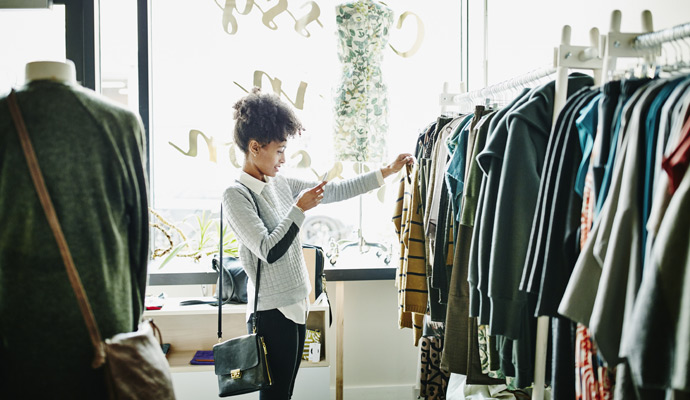Brick-and-Mortar Retail Is Alive and Well
As growth in e-commerce slows, physical stores have an opportunity to attract customers to their doors.
Contrary to popular belief, brick-and-mortar stores have not succumbed to the Internet, and they are far from dead. Over the last several years, leading retailers have been adapting their business models to keep pace with a changing landscape — rethinking their physical presence in new and creative ways, using big data to better understand their customers, and harnessing the power of brands in order to raise their profile.
Meanwhile, industry data published in the Robin Report shows that the annual growth rate of e-commerce is slowing: from 30 percent in 2004 to roughly 16 percent in 2014, and is projected to be less than 10 percent in 2018. The Robin Report also says that in 2014, about 80 percent of sales took place in stores, whereas e-commerce represented only 6 percent of the US$4.5 trillion spent in the U.S. alone. In addition, half of these e-commerce sales took place in a brick-and-mortar shop, for example, through emailed offers collected by shoppers in-store.
In my previous post, I wrote about how some big retailers (Macy’s in New York, Le Printemps in Paris) are transforming themselves into “retail palaces,” targeting the high-spending tourist who wants to break up relentless museum visits with shopping. Such experiments have seen early success, but they are dependent on a vibrant luxury tourism market.
Another trend is lying in wait: Retail outlets will become more like showcases for virtual warehouses full of products to be ordered online. “We’ll see less actual retail selling space and more space devoted to service [food, advice, and entertainment],” says Bryan Gildenberg, chief knowledge officer at Kantar Retail in Manhattan. He believes that people will go to stores for social interaction and instant gratification, rather than waiting for delivery of online purchases at home. Gildenberg predicts that “there will be fewer physical products and more virtual choices. Salespeople will need to be more tech-savvy.”
People will go to stores for social interaction, rather than wait for delivery at home.
Retailers can also use big data to draw customers to their doors. Loyalty programs and personalized service are becoming more important in the quest to develop customer relationships, and will be further enabled by technology. Today’s electronic measurement tools allow retailers to obtain a 360-degree view of customers’ habits, creating sales marketing segmentation based on purchasing information from all available channels. By tracking a customer’s every move and penny spent, retailers can offer reasons to come back: special offers, perks, discounts, and other opportunities.
“People will happily share things about themselves as long as there is a benefit to them and as long as you are responsible with that information,” Gildenberg says (of course, some backlash is inevitable). He also suggests that in the future, personal data could build customer leverage. “Instead of bargaining on price, the now 20-something shoppers will be bargaining for a better return on their data — essentially demanding more privileges and perks that money can’t buy in exchange for handing over vital statistics.”
Finally, the smart general or department store retailer will embrace the power of brands as the key to success in the multichannel environment. “The brand story will play out in all retail channels, creating a virtual reality in tandem with real items,” says Gildenberg. “We’ll see increasing content — kind of a ‘world of the brand’ saga, like Disney and Disneyland, that portrays the core values of the brand — and customers will become more involved in this content or story.” There is already, after all, a World of Ralph Lauren, Armani/Casa, and brand-designed hotel rooms and car interiors. The next step, Gildenberg believes, could be media platforms, movies, and music, permeating the world as we live, think about, and experience it: a parallel universe.
General retailers are already harnessing brand power with in-store boutiques — spaces conceived, built, and managed by the brand within the department store (which then receives rent and other revenues from the brand). It’s a concept long used in Europe, and brands love it. “It gives you total control over everything, from display to pricing, rather than standing back and waiting to see how the retailer will position your products,” says Mark Weber, former chairman of Donna Karan International and of LVMH North America.
That control is what has made brands such as IKEA and Zara the undisputed lords and masters of their respective retail spaces. They are customer-centric and available wherever the increasingly mobile customer happens to be in the world, including online. In Europe, IKEA allows customers to scout online and either have the item delivered or collect it in-store; the website will tell them in which store the item is available, as well as which aisle and shelf. The company plans to continue to invest in and expand its online presence. Even as other big retailers competing solely on price have fallen by the wayside, and landmark retailers such as Walmart are seeing declining sales, IKEA and Zara are growing — building customer loyalty and boosting business through adroit use of technology, blending online and in-store sales channels, and strictly monitoring their supply chains and production facilities.
Smart retailers are also expanding joint promotions with brands to attract customers both in-store and online: For example, “receive a free gift from Brand X with a $25 purchase, only at Macy’s.” And now that more personal customer data is available, the promotions can be targeted to individual clients, offering customers something they want (on the evidence of data relating to past purchases and habits) rather than something the retailer wants to sell.
Retailers must change their approach accordingly. It’s that or risk losing business as brands reach out directly to their faithful clientele via emails, texts, and old-fashioned phone calls inviting them to shop in flagship boutiques — sidestepping the large retailer altogether.




